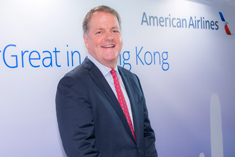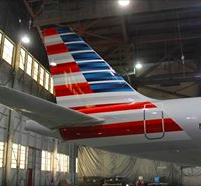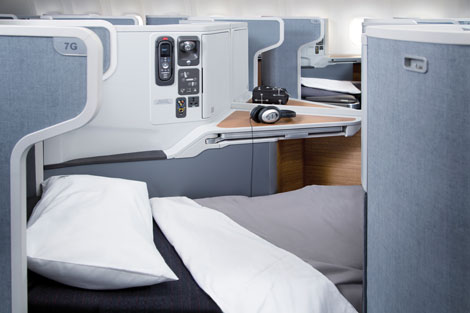 A team of American Airlines (AA) corporate heavyweights led by chairman and chief executive Doug Parker were in Hong Kong today to celebrate Asian expansions, including the first anniversary of the Hong Kong to Dallas/Fort Worth route, and downplay conflicts between US and Gulf carriers over open skies agreements.
A team of American Airlines (AA) corporate heavyweights led by chairman and chief executive Doug Parker were in Hong Kong today to celebrate Asian expansions, including the first anniversary of the Hong Kong to Dallas/Fort Worth route, and downplay conflicts between US and Gulf carriers over open skies agreements.
A gathering that included Parker, executive vice president of corporate affairs Stephen Johnson and vice president Asia-Pacific Erwan Perhirin was upbeat about AA’s outlook in the region following key expansions in mainland China and Hong Kong, as well as a new route from Los Angeles (LAX) to Sydney and the addition later this year of a service to Tokyo’s Haneda Airport, dropped by Delta Air Lines from October 1.
But when asked about the open skies dispute with Gulf carriers today, the AA chief was quick to frame it as a matter between governments rather than airline chiefs.
“The dispute is one where three large US airlines have petitioned the US government to enforce our trade laws, that happens to be an open skies agreement,” he said.
“We are as pro open skies as anyone else in the world, indeed so much of what I talk about with the success of AA is due to open skies agreements. But those agreements also provide for – when the playing field is so tilted, as it appears to be with what’s going on with the governments in the UAE and Qatar – to [be able] to ask [government] for consultations.
“So it’s now a foreign policy issue rather than an airline versus airline issue, and one that we think is important, and that has real impacts on global aviation.”
Accusations of subsidisation, and subsequent unfair operational advantage, have been levelled by both sides and advanced to the recent point where Qatar Airways chief executive Akbar Al Baker said his airline may withdraw from the Oneworld alliance (see here).
“There is no point in us being in Oneworld if an airline [AA] that invited us, hosted us in America to sign the entry to Oneworld, is today going against us,” Al Baker said.
Parker said Oneworld and the subsidies dispute were two different things. “We have this issue with Qatar that they aren’t pleased about, we understand where they are, but that hasn’t had an impact on the [Oneworld] relationship,” he said. “We look to Oneworld as a means of providing customers with the ability to get to places that we can’t take them, and the Middle East is one of those places. So that’s a marketing relationship that we view as separate from public policy.”
Regarding Al Baker’s comments he said: “AA is really happy in Oneworld and the partnerships there, and we hope that those partnerships continue to exist.”
When asked about the potential of the India market, Parker said it was “a prime example of where the subsidisation of the Gulf carriers has already hurt US carriers”.
“What the Gulf carriers have done thus far in parts of the US are for the most part flights from the Gulf to the US and the vast majority of those customers aren’t getting off the planes in the UAE or Qatar, they’re going on to India or China.
“So there’s so much capacity, therefore subsidised seats, flying into India, and the fare models simply don’t support US flights to India. Only United now flies to Delhi and Mumbai. But Delta and American have exited the market and we don’t have any clients to increase services because we can’t do it profitably against a subsidised service.”
Asia-Pacific
On the airline’s Asia-Pacific strategy, Parker said “a huge part” of a US$2 billion initiative to upgrade the airline’s international competitiveness included expansions in the region.
“That includes three new flights in the last year-and-a-half, doubling the number of flights AA has into China after adding Dallas to Beijing, Dallas to Shanghai, and of course Dallas to Hong Kong,” he said.
“We haven’t just added these new flights, we’ve put our best aircraft on them. Our flights to HK include our 777-300 product, that includes lie-flat seats with a walk-up bar and wifi over the ocean.”
 He said the eight-seat first class cabin to Hong Kong was usually a sellout, and mostly to corporate clients. “Hong Kong is one of the few markets around the world that can support a first class cabin. We know how important this part of the world is, and also to be the biggest airline in the world serving markets like HK (Hong Kong) and China.”
He said the eight-seat first class cabin to Hong Kong was usually a sellout, and mostly to corporate clients. “Hong Kong is one of the few markets around the world that can support a first class cabin. We know how important this part of the world is, and also to be the biggest airline in the world serving markets like HK (Hong Kong) and China.”
AA also announced recently plans to add a new flight from LAX to Sydney from December 17 subject to regulatory approval. “This part of the world is important. We have a great partner here in Cathay, and we look to continue to expand that relationship; what that means is more flights between the two of us to this part of the world,” Parker said.
Japan
On Japan, he said AA already had a firm foothold due to its strong partnership with JAL. “We were just awarded the ability [from LAX] to Haneda because of Delta being required to give up their flight route from Seattle, so we’re ready to begin that service in the not too distant future.
“Of the four routes that US carriers have to Haneda we now have one of them. We’d like to see more but we’re pleased to see the US government place demands on Delta [Air Lines] that they chose not to meet, and therefore now we can rectify with that route from LA.”
AA’s chief marketing officer, Andrew Nocella, added there had been no decision on whether the Haneda route, due in November or December, would impact on the airline’s regular daily 777-200 services from Chicago, LAX and Dallas/Fort Worth to Narita.
“Narita flights are good to fly to Japan to connect throughout the region, and Haneda flights are not the same because there’s less intercontinental connectivity there,” Nocella said.
Profitability
Parker said the airline’s profitability (more than US$4 billion in 2014) had fuelled a reinvestment into products for the future. “We’ve been investing in … a major modernisation effort for aircraft, bringing in along the lines of one new airplane every four days, replacing older aircraft.

Business class on the B777-300ER
“We’re lowering the age of the fleet and retiring older planes, and on top of all that we’ve announced a US$2 billion investment programme towards improving the product over and above the new airplanes – taking the product to a higher level to compete on a global scale.
“That includes putting lie-flat seats across our entire fleet of wide-bodied aircraft, adding wifi across our network, and also improving our Admirals Clubs to compete on an international scale.”
Merger progress
The AA chief said the airline’s merger with US Airways in December 2013 has now entered a second phase. “So far so good, but were not done,” he said. “We’re in the sixth or seventh inning of a nine-inning baseball game is probably the best analogy.”
The next phase of the merger involved more difficult work, including combining the airlines’ massive reservation systems. “We’ve two very large data bases that we need to combine into one. We haven’t done that yet, and we need to combine them before year end."
For more information, visit aa.com
John Church








